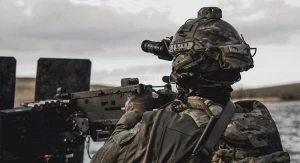
How FPV drones smashed Russian base and what was surprise for destroyed Su. Column by Serhiy Zgurets
The operation near Avdiivka was risky, demanding and effective, given that the air defense systems destroyed, among other things, Russian aircraft that had launched strikes with KAB glide bombs.
FPV drones hit a Russian base
I'll start with some good news that shows the rapid growth of our drone operators' skills. Of course, we are already used to utilizing attack UAVs to target Russian manpower and weapons. But among the good videos, there are also the best ones. The new video from the Bulava unit of the separate presidential brigade named after Hetman Bohdan Khmelnytskyi is just such a video. It is about the extremely demonstrative destruction of an enemy base or accumulation of equipment in hangars where two T-72 tanks, a Terminator tank support vehicle, BMP-3, two C-60 systems on ZILs, and trucks with ammunition were located.
So, our operators had to not only hit the hangar from above, but also to enter it, identify the specific target, and guide the attack drone toward it. Such consistent methodical strikes disabled all the equipment that Russian troops tried to hide in these hangars. And then it all ended with a beautiful explosion of ammunition. The scene was in the outskirts of Staromlynivka, Donetsk region, about 5-6 kilometers from the contact line. So in one working day, the fighters of the Bulava strike unit used drones worth about UAH 200,000 and burned tens of millions worth of enemy equipment. The attack drones themselves were manufactured and handed over to the brigade by the Wild Hornets volunteer team.
This whole story shows that the potential of drones is now becoming enormous, but it is a necessary step when drones are now compensating for the lack of artillery. The other day, the new commander of the Land Forces, Oleksandr Pavliuk, said that in recent days, about 70% of targets have been destroyed by unmanned means. Previously, 80% of enemy targets were destroyed by artillery, which is why the production of these drones and their delivery to the army is so important.
UAVs for the Ukrainian Armed Forces from the Drone Coalition
The goal is to produce 1 million FPV drones in a year. I think this is an achievable goal. Similarly, our partners from the Drone Coalition promise to supply us with one million drones for various purposes, and this process is already underway. Let me remind you that the Canadian government has announced that 800 SkyRanger R70 drones from Teledyne FLIR will be transferred to Ukraine. This is a good product, a quadcopter drone, which is quite expensive and costs about USD 80,000. However, this drone has a significant advantage due to its optics and other technical solutions. We expect such drones to be delivered in the spring of this year.
We have already started using British-made attack drones. Now Russia is trying to analyze the remains of this drone in one of the areas where the enemy is still occupying our territory. This is a drone called Banshee Jet 80 from the British company QinetiQ, which develops jet targets. In 2023, they promised to supply us with a significant number of attack drones based on this particular target. And we see that they are already being used on the battlefield. Such drones can cover a distance of up to 200 km and have a warhead weight of 3 to 7 kg. This is a serial model that is already being manufactured at British facilities.
Let me remind you that a couple of weeks ago, the UK announced that it would provide a package of GBP 200 million to Ukraine, which would include the possibility of using these funds to purchase attack drones like Banshee, FPV drones, and reconnaissance drones. The UK has also announced that within a few months, it will provide Ukraine with drones that will use artificial intelligence technology.
The crucial aspect is ensuring that the promised drone deliveries occur promptly, unlike the sporadic delivery of ammunition as previously experienced. I hope that our partners will exhibit greater efficiency in supplying drones. Nevertheless, it is noteworthy that Ukraine’s domestic industry has been adept at providing drones for the requirements of our military.
Avdiivka
Ihor Romanenko, founder of the Safe Skies Charitable Foundation, General and Deputy Chief of the General Staff of the Ukrainian Armed Forces (2006-2010), commented on the fighting for Avdiivka. Russian troops had a military and political task from Putin to capture the city. From a military point of view, Avdiivka was the closest point to Donetsk. The Russians were pushing our troops back, removing the Avdiivka agglomeration from the defense system of the Ukrainian Armed Forces. They wanted to get military prospects for further advancement because Avdiivka is geographically located on a high ground. This means that it opens up prospects for the Sloviansk-Kramatorsk agglomeration, and Pokrovsk is also an operational level area.
So, from a military point of view, there are prospects. We also need to keep in mind that the shrinking of the frontline means that Russia is freeing up some troops. The initial Russian attacks demonstrated superiority in manpower, weapons, and equipment. Following a regrouping phase, the invaders are expected to establish a new reserve. Presently, they are in the process of regrouping for upcoming actions.
Fighting Russian Sukhoi aircraft
The General emphasized Russia's intensified efforts in targeting Ukraine's facilities with gliding aircraft bombs. This concentration of forces signifies Russia's enhanced capabilities, particularly in cannon artillery, MLRS, and air defense systems. The most formidable and efficient weaponry deployed by Russian forces in recent days includes guided aerial bombs (KAB), with approximately 60 such bombs being utilized. The effectiveness of these bombs is significant because it was clear that our side was looking for ways to combat them. While air defense systems can intercept the bombs, it presents challenges. The most efficient approach is preemptive action by neutralizing the launch platform before any weapons are deployed, i.e. destroying aircraft and ships prior to launch. Accordingly, we need to counter this, but the question is: where can we get such means? Medium- and long-range air defense systems can be a means, and we have a small number of such systems, and they have anti-missile capabilities. These systems had to be removed from certain locations and unexpectedly relocated. There were three options for the SAM: Patriot, SAMP/T, or the Franken SAM program. That is, they took risks in some regards, removed these systems, moved them, and, accordingly, used them unexpectedly. This use of the systems was effective and predictable. The destruction of three enemy Su aircraft is an example of this approach.
Romanenko noted that these air defense systems are deployed to a location, perform a task, and then have to return. First, they need to move after the launches to avoid being destroyed. And secondly, we must remember that Russia uses ballistics almost every day, and we have few air defense systems that have anti-missile capabilities. Accordingly, the air defense systems must return and cover objects from ballistic missiles. This is a big responsibility of the Air Force leadership, at least, and this issue was discussed with the Commander-in-Chief, General Syrskyi. And given that they were taking these weapons from ballistic missile cover sites, this discussion could have been at the level of the president.
In summary of the discussion with the guest, the operation near Avdiivka is characterized as risky, demanding, yet effective. Notably, the air defense systems successfully neutralized Russian aircraft deploying KAB bombs. Ukrainian Air Force spokesman Yuriy Ihnat, on February 20, indicated a decrease in Russian aircraft activity, suggesting a potential recovery period from the surprise tactics employed. The aim is to continue delivering unexpected blows to the enemy, ensuring that such surprises become a recurring factor.
- News












































